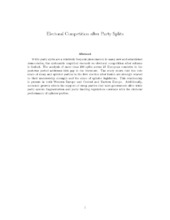| dc.contributor.author | Ibenskas, Raimondas | |
| dc.date.accessioned | 2020-06-19T08:26:31Z | |
| dc.date.available | 2020-06-19T08:26:31Z | |
| dc.date.issued | 2020 | |
| dc.Published | Ibenskas R. Electoral competition after party splits. Political Science Research and Methods. 2020;8(1):45-59 | eng |
| dc.identifier.issn | 2049-8470 | |
| dc.identifier.issn | 2049-8489 | |
| dc.identifier.uri | https://hdl.handle.net/1956/22760 | |
| dc.description.abstract | While party splits are a relatively frequent phenomenon in many new and established democracies, the systematic empirical research on electoral competition after schisms is limited. The analysis of more than 200 splits across 25 European countries in the post-war period addresses this gap in the research. The study shows that the vote shares of rump and splinter parties in the first election after fission are related to their membership strength and the share of splinter legislators. This relationship is present in both Western Europe and Central and Eastern Europe. Additionally, economic growth affects the support of rump parties that hold government office while party system fragmentation and party funding regulations correlate with the electoral performance of splinter parties. | en_US |
| dc.language.iso | eng | eng |
| dc.publisher | Cambridge University Press | eng |
| dc.title | Electoral competition after party splits | eng |
| dc.type | Peer reviewed | en_US |
| dc.type | Journal article | en_US |
| dc.date.updated | 2020-01-22T08:31:18Z | |
| dc.description.version | acceptedVersion | |
| dc.rights.holder | Copyright The European Political Science Association 2019 | en_US |
| dc.identifier.doi | https://doi.org/10.1017/psrm.2019.15 | |
| dc.identifier.cristin | 1714847 | |
| dc.source.journal | Political Science Research and Methods | |
